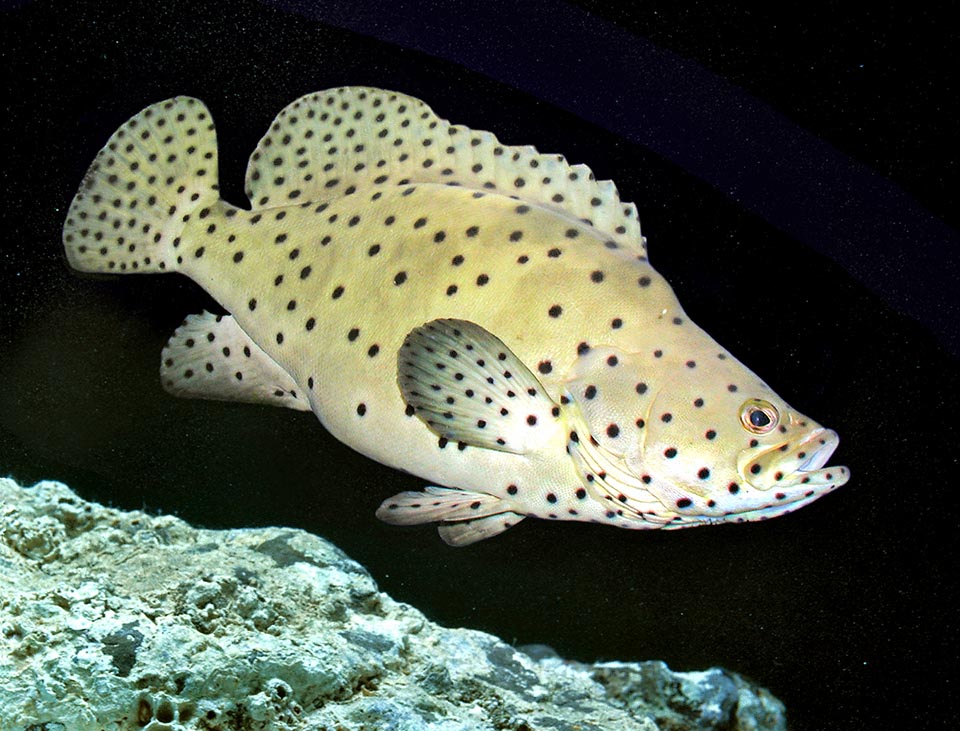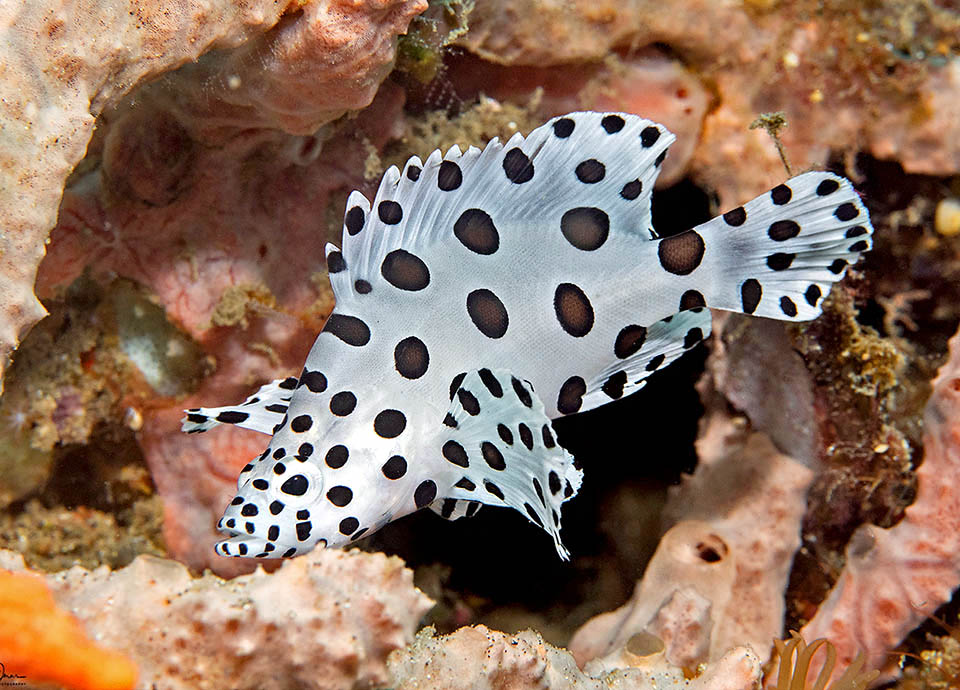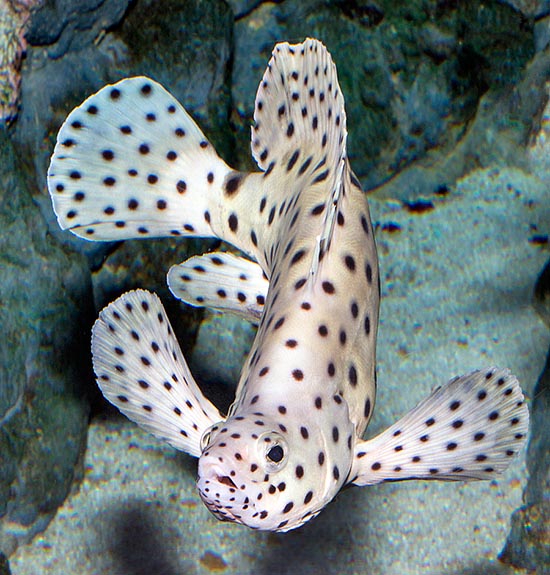Family : Serranidae

Text © Giuseppe Mazza

English translation by Mario Beltramini

Cromileptes altivelis is an atypical grouper, appreciated for its flesh and beauty, present in the tropical waters of eastern Indian and of western Pacific Oceans © G. Mazza
The Humpback grouper (Cromileptes altivelis Valenciennes, 1828), belongs to the class of Actinopterygii, the ray-finned fishes, to the vast order of Perciformes and to the family of Serranidae which counts more than 500 species.
The name of the genus comes from the Greek “croma” = colour and “leptos” = delicate, due to the white-black contrast shading with the age in pastel hues. When young, in fact, this fish is pure white with great black spots, then, growing, these ones fade, increasing of number, whilst the background colour gets beige with grey-greenish shades.
The name of the species “altivelis” from the Latin “altus” = high and “velum”) sail, refers to the showy dorsal fin.
A curiosity concerning France and the Principality of Monaco.

The juveniles are almost white with big dark mimetic spots to elude the gaze of the predators. In French, besides as “Mérou bossu”, that is Humpback grouper, it is vulgarly known also as “Mérou de Grace Kelly”, that is Grace Kelly grouper, with reference to the famous actress and Princess of the Principality of Monaco © Rafi Amar
It seems that the beauty of juvenile livery of this species has particularly stricken, in front of the photographs, the attention of the Princess Grace Kelly while visiting the Oceanographic Museum of Monaco, whilst others affirm that the drawing of the juvenile livery reminds a white dress with black dots the actress was wearing in a famous movie. The fact remains that nowadays in France, close to the old vulgar name of “Mérou bossu”, circulates, with full right, also in the web, the name of “Mérou de Grace Kelly”.
Zoogeography
The humpback grouper is a species present in the tropical waters of the Eastern Indian Ocean and of the Western Pacific. We find it, indicatively, along the coasts of East Africa and then in India, Sri Lanka, Thailand, Malaysia, Singapore, Australia, Indonesia, New Guinea, Palau, Philippines, Taiwan, China and up to the Ryukyu Islands in the southern part of Japan. Southwards, after the Great Barrier Reef, it reaches New Caledonia.

Even if nowadays it is bred for the aquaria, it appears, like all groupers, endangered as it is too much fished for food purposes before having the time to reproduce © Giuseppe Mazza
Ecology-Habitat
It lives among the madrepores and the corals in relatively shallow waters, usually between the 2 and 25 m of depth, but it can go down even to 40 m. It is not rare to find juveniles in the rock pools.
Morpho-physiology
In nature, the Cromileptes altivelis can reach the 70 cm of length. At first glance, the flat body and the small head, elongated, with concave profile almost drawing a hump in the fore part of the back, certainly do not seem a grouper, but the great protractile oblique mouth, the longer lower jaw, the teeth and the hunting modalities rapidly dispel the doubts. The dorsal fin counts 10 spiny rays and 17-19 soft, but, above all, it beats any record of height in the world of the Serranidae exceeding often that of the body; the anal has 3 spiny rays and 9-10 unarmed; the caudal is more or less rounded at the borders; the pectoral ones are long, spatulate and rounded at the apex, whilst the ventral are of modest size.
Growing, besides the aforementioned variations of colour, this fish changes also the way of swimming: from a waddling and funny gait to the slow and solemn movements typical of the big groupers.
Ethology-Reproductive Biology
Apart the reproductive period, it is a territorial and solitary predator hunting in ambush, mostly during the twilight hours, nourishing mainly of fishes and crustaceans.
It is a protogynous hermaphrodite species, that is, with females that, at a certain age, may transform into males. Numerous fecundated eggs are entrusted to the currents, but the growth is slow and the sexual maturity is reached only when 39 cm long when a good part of the individuals has already been fished. In order to double the populations decimated by the events, in optimal conditions, are needed from 4,5 to 14 years. The fishes intended for the aquaria market are nowadays all bred, but this is a too much exploited for food, subject also to the deterioration of the reefs related to the climate changes.
The biologists of the Red List survey it, inserting it now as “Data deficient“ among the species for which there are not enough elements to consider them as endangered.
Synonyms
Epinephelus altivelis Valenciennes, 1828; Serranus altivelis Valenciennes, 1828.
→ For general information about FISH please click here.
→ For general information about BONY FISH please click here
→ For general information about CARTILAGINOUS FISH please click here.
→ To appreciate the BIODIVERSITY of BONY FISH please click here.
→ To appreciate the BIODIVERSITY of CARTILAGINOUS FISH please click here.
